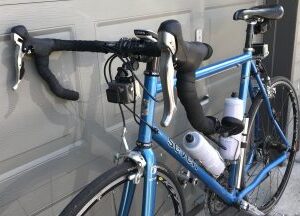
(Photo: J. Maus/BikePortland)
This is the latest in our Get Legal column sponsored by Portland law firm Thomas, Coon, Newton & Frost.
In our current era of widespread “stay home” orders, heading out for a neighborhood walk or jog is among the few available forms of exercise. With relatively high volumes of sidewalk traffic, and a desire to maintain appropriate social distances, many people find it necessary to divert from the sidewalk and walk or run, at least temporarily, in the roadway. People on foot have ample right-of-way protections on sidewalks and when using marked or unmarked crosswalks.
However, when walkers stroll into the roadway, their rights with respect to other road users diminish significantly.
Oregon Revised Statute (ORS) 814.070, “Improper position upon or improperly proceeding along highway,” is a pedestrian-equivalent to Oregon’s “mandatory side path law” for bicyclists. Just as ORS 814.420 requires bicycle riders to use a bicycle lane when one is available (subject to several important exceptions), ORS 814.070 prohibits people on foot from, “Tak[ing] a position upon or proceed[ing] along and upon the roadway where there is an adjacent usable sidewalk or shoulder.”
Advertisement
“While pedestrians enjoy significant right-of-way protections on the sidewalk and in crosswalks, when otherwise travelling in the roadway they must yield to vehicle users, including drivers and bicycle riders.”
Of course, in the age of mandatory six-foot buffers between sidewalk users, a pedestrian using the roadway could argue that the sidewalk was not “usable” because it was occupied by another (potentially virus-carrying) person. However, even if that person is legally entitled to be in the roadway, ORS 814.040 requires, when outside of marked or unmarked crosswalks, that they “yield the right-of-way to all vehicles upon the roadway.” In other words, while pedestrians enjoy significant right-of-way protections on the sidewalk and in crosswalks, when otherwise travelling in the roadway they must yield to vehicle users, including drivers and bicycle riders.

Fortunately, in many parts of Portland, motor vehicle traffic is light, making compliance with Oregon law while in the roadway relatively straightforward. However, in the city’s denser areas, or on streets with high vehicle traffic volumes, pedestrians forced to use the roadway face additional risk of injury without legal recourse.
Interestingly, ORS 814.070 has a section that could address temporarily extended sidewalks, like the ones that have emerged in some cities and here in Portland from a concerned citizen who’s taken things into his own hands. Section 4 of the law says a pedestrian on a “narrow residential roadway” can legally walk in the road if they aren’t creating a “hazard” and if signs have been posted “giving notice that pedestrians may be present upon or along the narrow residential roadway.”
— Chris Thomas, @ChrisThomasPDX on Twitter.
— Get our headlines delivered to your inbox.
— Support this independent community media outlet with a one-time contribution or monthly subscription.






Thanks for reading.
BikePortland has served this community with independent community journalism since 2005. We rely on subscriptions from readers like you to survive. Your financial support is vital in keeping this valuable resource alive and well.
Please subscribe today to strengthen and expand our work.
There’s a city ordinance or code about this too, something to the effect that is the roadway is under 18 or 20 feet and has no sidewalk, you can walk in the street. Not that it helps much in most of Portland…
Of course it’s against the law.
Since we’re not doing any meaningful traffic enforcement, and haven’t been for a couple years, will it really make any difference?
Remember the “soda choke” driver who killed a pedestrian on Morrison Bridge? There are no meaningful consequences for drivers, so why worry about it?
As I remember it was the Burnside bridge.
I wouldn’t be worried about getting a ticket for using the street, but I would be worried about not being fairly compensated if an inattentive driver hits me while I’m in the street.
One more strike against sidewalks. On streets without many vehicles, and no sidewalks, you can walk in the whole street, then move over if a car is coming. And drivers go more slowly knowing there will be people in the roadway. I’d like to see way more “Local access only” streets, and more “Pedestrians may be present…” and even “Pedestrians have the right-of-way” signs (understanding that may require a law change).
People who think you can’t mix people and cars should go to any parking lot in the city. Costco or any mall has 10x or 100x more vehicle traffic than many streets, with half the cars driving backwards, and it all works fine–I’d guess in large part because drivers expect to see people walking, and they can’t tell themselves that those people don’t have a right to be walking there.
In contrast, on streets, especially those with sidewalks, drivers (and the law) view pedestrians as lawbreakers who have no right to be there.
Streets with light traffic, but with sidewalks, are the most wasted real estate in the city.
As a practical matter, walking on streets is not a problem. In fact it’s easier than parking lots where vehicles are moving in different directions, often in reverse when drivers can’t see.
I’ve walked on streets and highways of all types for many years at all times of day and night. Cops are a nonissue. I’ve been stopped and questioned many times (often for seriously stupid stuff), but I’ve never ever simply been hassled for walking on the street. ROW is a nonissue. Cars rarely are on a trajectory to hit you, the vast majority steer around you if they are, and you can easily get out of the way of the miniscule percentage that don’t notice you or are otherwise miscreants. Cycling on the streets is safe, and walking even safer because the dynamics are such you get sooner and more precise information about what vehicles are doing and can plan accordingly.
My consistent experience as a ped/runner is that cyclists are a bigger issue in the PDX area than cars (or more accurately, cyclists can be an issue and cars aren’t ). The vast majority also provide plenty of clearance as there’s no excuse for a bicycle ever being near a ped on the road, but the cluelessly entitled and the idiot ride silently, unlit, and uncourteously.
I’m a unclear on why people think it’s too crowded to be out there. I go out every single day at different times to run, walk, and cycle. My consistent observation is that people appear in specific places and specific corridors at specific times, but that other places nearby (literally a block away) are empty.
The picture for this article exemplifies exactly why I’m opposed to making the streets a free for all. There’s plenty of space, but people are using it in such an unnecessarily wide and inconsiderate fashion that it is literally impossible to pass with adequate clearance. I see this dynamic in “popular” areas during key times. I’d guess that there are literally zero peds or cyclists if you’re one block over or on the side streets. I see this dynamic literally every day.
Well stated. 99+% of the time nobody is within 10 feet of you. And if one is paying attention to what they are doing, it is not difficult to maintain that distance. This is making it sound like everything is a crowd at the Mardis Gras.
I don’t see anything being said about streets or sidewalks being crowded like Mardi Gras. I just see good information about the legality of walking in the street. And if you want to keep 6′ apart from people, you literally can’t pass someone on a typical sidewalk, so one person has to go into the street, or cross the street. When I’m out walking my dog, I may only come across a dozen other people, but several times (every time we find each other heading towards each other on a sidewalk) one of the other of us has to cross the street or walk into it.
Except parking lots are not roads. There is a common knowledge that you don’t speed in parking lots, and unlike roads, they are not designed to move cars rapidly from one place to another.
Yeah, they are both made of pavement and contain people and cars, but the intended uses are vastly different.
And if you notice, Costco parking lots do indeed have walkways in them. Most people just choose to not use them.
Yes, I know parking lots are not roads, and that there’s common knowledge you don’t speed in them. That’s exactly my point. People can learn. Parking lots physically are unsafe environments, with hundreds of cars going in and out and people walking everywhere in their midst, but they’re safe because drivers have learned to drive slowly and attentively in them.
People can and do learn to drive safely on streets. People who live on narrow neighborhood streets with no sidewalks, who are used to people walking on them, drive very safely. The woonerf concept is based on that, and it works.
I also understand that parking lots are not designed to move cars rapidly from one place to another, but most roads are. That’s exactly my point also. Many streets could be transformed with a few signs and barricades into local access only streets, where people either can’t drive fast or won’t want to. The concept that all streets should allow people to drive at least 20 mph or more was never a good one.
I also understand that Costco parking lots have walkways in them. So do all large newer parking lots in Portland, because it’s a zoning requirement–connection from public way to main entrance, minimum width, differentiated surface material, raised, etc. Yes, they’re hardly ever used, because people don’t feel any need to walk more than a few feet to get to them, because they don’t feel unsafe walking amidst the cars. I don’t know the relevance of the walkways to my point, other than that their low use proves that people don’t have to feel unsafe walking among moving cars, in the right environment.
Now we don’t have to go all the way to Oak Grove to do crimes!
well, it seems mostly a white person thing so more than likely, there will be minimal enforcement until the white folks are back in their SUV’s running down people walking and biking. Then more minimal enforcement.
Racist much Mark?
The street is so crowded that it’s hard to yield the right of way to any vehicles because you have to wait for the sidewalk to clear before you can move over there.
Since pot became legal I have been wondering how to earn my street cred. I am back baby
Comment of the Week as far as my opinion goes.
You should also the Portland police about enforcement based on skin color. Or any police Dept for that matter.
Naturally, this can be more acute in denser parts of the city – I’m basically always in the street walking around NW Portland these days. I’m not entirely surprised to learn this is technically illegal, but I’ve been passed by a number of police cruisers (weirdly, a lot more of them these days than usual) while in the street – sometimes pulling a wagon – without any issue. I wouldn’t doubt my pale, pasty complexion helps in that regard.